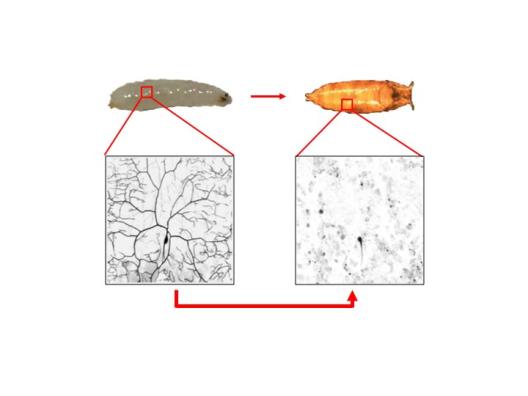Dr. Sebastian Rumpf
Developmental Neurite Pruning as a Morphogenetic Mechanism

Cell Biology / Molecular Biology
Development
Neurobiology
Neurons possess two types of processes, axons and dendrites. While neurite outgrowth and targeting have long been recognized as crucial processes during development, degeneration of specific neurites (sometimes followed by regeneration with adapted morphology) is also a pervasive developmental phenomenon used to make the neuronal circuitry more specific. Such degenerative processes are also known as „pruning“. In Drosophila, pruning occurs at large scale during the pupal phase. For example, the nociceptive sensory c4da neurons have long and branched dendrites in larvae which are completely pruned during the pupal stage, only to be regrown with adult morphology later. Dendrite pruning is a stunning example of spatial regulation: in the dendrites, the cytoskeleton is locally destroyed and the plasma membrane is cut at a predetermined break site, all the while, the cell body and axon are maintained. C4da neuron dendrite pruning can be easily followed by live imaging over extended periods of time. Together with the formidable genetics of the fly, this is a powerful system to identify the cell biological mechanisms underlying pruning. Current areas of interest include cytoskeletal and spatial regulation as well as the effect of pruning on behavior.

Vita
- 1995 - 2000: Studies in Biology, University of Heidelberg
- 2001 - 2006: PhD at the Max Planck Institute of Biochemistry, Martinsried
- 2006 - 2013: Postdoc at the University of California, San Francisco
- Since 2013: Group leader, “Cells in Motion” and DFG Heisenberg programme
Selected references
Sanal N, Keding L, Gigengack U, Michalke E, Rumpf S. (2023) TORC1 regulation of dendrite regrowth after pruning is linked to actin and exocytosis. PLoS Genetics 19: e1010526.
Krämer R*, Wolterhoff N*, Galic M, Rumpf S (2023). Developmental pruning of sensory neurites by mechanical tearing in Drosophila. Journal of Cell Biology 222: e202205004
Marzano M, Herzmann S, Elsbroek L, Sanal N, Tarbashevich K, Raz E, Krahn MP, Rumpf S (2021) AMPK Coordinates Metabolism with Energy Requirement During Developmental Dendrite Pruning in Drosophila. Cell Reports 37: 110024.
Rode S, Ohm H, Anhäuser L, Wagner M, Rosing M, Deng X, Sin O, Leidel SA, Storkebaum E, Rentmeister A, Zhu S, Rumpf S (2018). Differential Requirement for Translation Initiation Factor Pathways During Ecdysone-Dependent Neuronal Remodeling in Drosophila. Cell Reports 24:2287-99.
Herzmann S, Krumkamp R, Rode S, Kintrup C, Rumpf S (2017). PAR-1 promotes microtubule brakdown during dendrite pruning in Drosophila. EMBO J 36: 1981-91
Links
